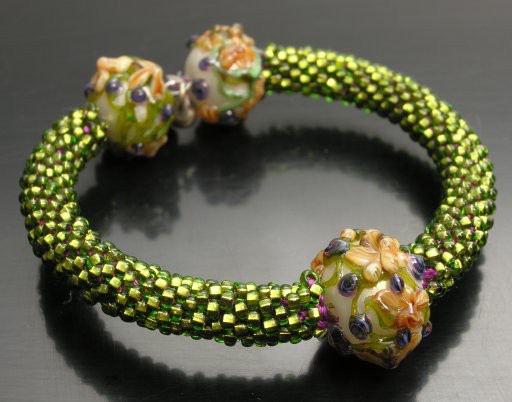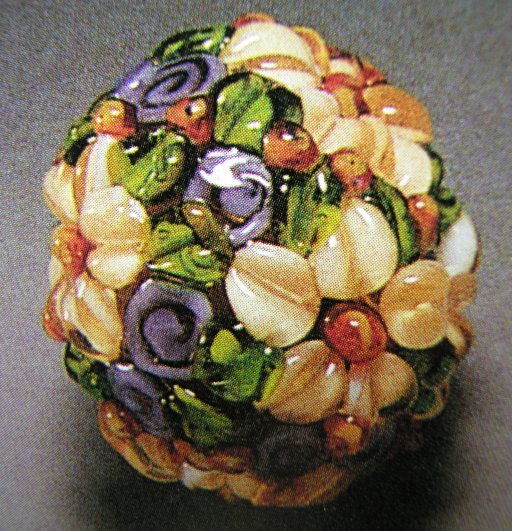Somewhere or other—one of the bead-stringing mags, I suppose—I saw a wonderful collaboration between two beadmakers, one of whom was doing thompson enamel abstracts (in purple and green, no less!), the other, Leah Zinke, did co-ordinating florals all tied together with some really lovely wire-work. (Scroll down/search for ‘the garden floral series.’ —Normally I would just turn you loose on to her index page, but as of this writing it greets with you music and animation, and I, personally, can't abide my computer unexpectedly muzaking at me.)
I encountered her floral series again, along with my sister, probably at Bead&Button 3–4 years ago. This time, the artist had a garden floral on beaded crochet bracelet, which my sister really liked. I really liked the piece too, not least because I have an interest in combining beaded crochet and lampwork and with the impetus that someone else would actually enjoy having it, offered to make her a similar one.

beaded crochet bracelet. rocaille seed beads, silk, memory wire, effetre lampwork, sterling silver. completed 2006. private collection.
I wasn't trying to copy Ms Zinke's beads; I was attempting to get the same basic style (floral) and color scheme (cream, green and purple). So here is an image, excerpted from 1000 Glass Beads (p. 124) to give you an idea of what the model looked like:

This image—about a square inch in the original publication—is excerpted from 1000 Glass Beads. I feel I'm within fair use laws to show 0.1% of this publication, but, needless to say Lark books and Leah Zinke hold copyright on the original image.
I wanted the same basic ‘feel’, but you can see some fairly obvious differences: the original has no negative space, certainly none with pixie dust. I didn't use any specially hand-mixed colors, though I did pull my own canes. She also has these charming purple curliQs which are considerably more loosely executed in my beads. Overall I would say the biggest difference is that she's working colder, and much more deliberately, which along with the total lack of negative space gives that yummy, yummy texture. That aspect of the bead I failed to capture, at least this time around.
I should also note that this was the piece that taught me to crochet around a core, usually of thick doubled cotton yarns, to make threading the sections of crochet easier. My finish leaves something (quite a lot, actually) to be desired, and were I doing this again, I'd incorporate some silver caps to hide my wretched crochet ends. Also, my hopes for cool visual interaction between the acid green rocailles and purple silk basically...flopped.
This post points up several things. One is that I wish the images on her site were bigger. The quality of my reproduction from the book is considerably degraded, because of the realities of book publishing (it's all screened dots) . So I can't really show you just how fabulous her work is, something I know from seeing it in good reproductions and ‘in the glass’.
It may simply be a bandwidth issue. It may simply not have occurred to the artist that ‘life-size’ is fine for a bead, but needs to be considerably magnified for computer monitors. These are the reasons my older images only go up to 512 pixels, for example. But there are people out there who feel smaller, less informative images mean that, ‘well, it least people can't use her site to “steal” her work’ but as I've just sort of proved, no, it's not gonna stop people from copying/adapting/being inspired by her work. It does, however, make it more difficult for genuine buyers to judge its beauty. You have to take my word, or worse, the artist's (which can't be presumed to be disinterested) for it.
Life would be simple if these issues could just be boxed up into neat categories—this is outright theft, that is inspiration. But it's not, and the closeness of one piece to another always lies along a continuum, from exact copying on the one end to two artists coming up simultaneously with the same thing on the other, owing to their both being inspired by the great sea of what has come before us. That latter argument tends to be lost, over and over, as people focus on what's individually theirs, forgetting that none of us would be beadmakers or storytellers or rocket engineers nor much of anything else except animals digging for grubs and cattail roots without the efforts of those giants who came before, and the interlocking dependencies of society that give us the leisure to specialize.
In this case, the connection between my piece and Ms. Zinke's is obvious, not least because I've emphasized it. (Compare the beads in the bracelet to this series. Do the beads in the bracelet now seem to be more ‘mine’ than Ms. Zinke's? Why or why not? There will be a test Tuesday:) To be clear, while I feel my beads are ‘inspired’ the bracelet, common as the base design is, seems to me more like a copy: perhaps because so many beadmakers make florals, whereas beaded crochet bracelets with lampwork centers are relatively rare; or perhaps because I retained the design and the color combination and the materials. —Which illustrates just how much of a judgement call this sort of thing truly is.
Whether my bracelet would be different enough from hers for me to have the right to sell it is ambiguous, which is why I made it moot from the outset, by choosing even before I bought the seed beads to give it away. (Unlike a few people, I do feel copies not sold are always a legitimate, not to mention time-honored, way to learn.) Perhaps a better question is whether the ‘original’ artist is helped or harmed by my transaction? —I'd hoped, helped, if by chance someone reading this has been introduced to her work, or (even better) helped to see its special qualities by this post. (Florals are cool, but I do get the sense that sometimes people treat them as the romance-category of the bead world. I'd definitely like to change that.)
—respectfully submitted, sylvus tarn
file created 11jan07.
Unless otherwise noted, text, image and objects depicted therein copyright 1996--present sylvus tarn.
Sylvus Tarn